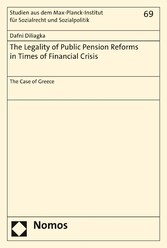Suchen und Finden
Mehr zum Inhalt

The Legality of Public Pension Reforms in Times of Financial Crisis - The Case of Greece
Cover
1
Introduction
15
A. Background
15
B. The Subject-Matter of the Book
16
I. Aim of the Book
17
II. Legal Research Questions
18
III. Methodology
21
IV. Progression of the Argument
22
Chapter One: The Influences of the Pension Reforms 2010-2012
26
A. The Influences of the Pension Reforms Prior to the Financial Crisis
27
I. Normative Factors
31
1. International Guidelines on Pension Reforms
31
2. European Economic and Monetary Union
33
3. Open Method of Co-Ordination
35
II. Factual Factors
38
1. Financial Imbalances in the Greek Public Pension System
38
2. Demographic Changes
41
B. The Influences of the Pension Reforms After the Financial Crisis
44
I. The Financial Crisis
44
II. The Conditionality of the Financial Facility Agreements
47
1. The Content of the Financial Facility Agreements
47
2. The IMF’ Policy of Conditionality
53
3. The Legal Status of the Agreements and their Element of Conditionality
56
III. Concluding Remarks
61
Chapter Two: The Greek Public Pension System 2010-2012
64
A. Overview of the Greek Public Pension System
64
I. Horizontal Dimension – Personal Scope of Coverage
66
II. Vertical Dimension – Form and Function
68
B. Pension Reforms Affecting Prospective Pensioners
71
I. Safety-Net for Elderly
73
1. Safety-Net Inside the Scope of the Pension System
73
a) Basic Pension
74
b) Social Solidarity Benefit (EKAS)
76
2. Safety-Net Outside the Scope of the Pension System
76
II. Proportional Pension
77
1. Qualifying Conditions
77
a) Pension Age: Pre and Post Crisis
78
aa) Normal Pension Age
78
bb) Early Pension Age
80
cc) Late Pension Age
81
b) Pensionable Service
82
aa) Minimum Pensionable Service
82
bb) Full Pensionable Service
83
cc) Recognition of Notional Insured Period
83
2. Financing
84
III. Supplementary Old-Age Pension Benefits
88
1. Qualifying Conditions
90
2. Objective and Calculation Method
90
IV. Further Regulations
92
1. Arduous and Unhygienic Professions
92
2. Invalidity Pension
94
3. Survivor’s Pension
96
4. Employment of Pensioners
98
C. Pension Reforms Affecting Current Pensioners
98
D. Concluding Remarks
103
Chapter Three: The Protection of Pensioners’ Existing and Future Legal Positions
106
A. Legal Provisions Protecting the Right to Old-Age Pension Benefits
107
I. The Right to Property
107
1. Protection of Allocated Pension Benefits
109
2. Protection of Pension Benefits to be Allocated in the Future
112
II. The Principle of Legitimate Expectations (Protection of Confidence)
117
III. Equality and Non-Discrimination
121
1. The Right to Equality
121
2. The Principle of Non-Discrimination
124
IV. The Right to Social Security
127
1. The Right to Social Security under International Law
127
a) The International Treaties (A Normative Description)
128
aa) Universal Declaration of Human Rights
128
bb) International Covenant of Economic, Social and Cultural Rights
128
cc) European Social Charter
130
dd) European Code of Social Security
131
ee) ILO Convention No. 102
133
b) The Right to Social Security as an Objective Right in International Law
135
2. The Right to Social Security under the Greek Constitution
140
a) The Constitutional Provisions
140
aa) The Right to Protection of Old-Age
140
bb) The Right to Social Insurance – Article 22(5)
141
b) The Right to Social Security as an Objective Right
142
c) The Right to Social Security as a Subjective Right
143
B. Concluding Remarks
149
Chapter Four: The Public Interest in Times of Financial Crisis
151
A. Public Interest and the State Power
152
B. The Financial Crisis as a Public Interest
159
C. The Aims of the Public Pension Reforms
163
I. The Sustainability of the Public Pension System
163
II. The Fiscal Interests of the State
168
III. The Proper Functioning of the EMU
178
D. Concluding Remarks
182
Chapter Five: The Principle of Proportionality as a Balancing Concept in Case-Studies of Pension Reforms
185
A. The Principle of Proportionality
186
B. Case-Studies
193
I. Reductions in Old-Age Pension Benefits
194
1. Reductions in Current Pensioners’ Pension Benefits
194
a) Application of the Right to Property
195
b) Reviewing the Proportionality of Pension Reductions
196
aa) Suitability
197
bb) Necessity
202
cc) Proportionality in a Narrow Sense
205
c) Respecting the Principle of Legitimate Expectations (Protection of Confidence)
216
d) Respecting the Principle of Equal Contribution to Public Charges
221
2. Reductions in Prospective Pensioners‘ Pension Benefits
224
a) The Increasing of Retirement Age as a Restrictive Measure
225
b) Do Prospective Pensioners have Legitimate Expectations that Transitional Measures will be introduced?
228
II. Reduction in Old-Age Pension Benefits of High Value
232
1. The Principle of Equivalence as an Aspect of the Right to Social Insurance
233
2. The Principle of Social Solidarity as a Ground of Justification
235
3. Proportional Balance between the Principles of Equivalence and Social Solidarity
237
III. Age Discrimination Cases
244
1. Mandatory „Pre-Retirement“ Reserve Scheme
246
2. Abolition of Bonuses for Pensioners Below the Age of 60
254
C. Outcomes of the Case-Studies
259
I. The Decisive Role of the Financial Crisis on Judicial Development
259
II. Enhancing the Right to Social Insurance
269
III. Limits on the Interference with Pensioner’s Rights
274
Conclusion
279
Bibliography
287
List of Documents
301
Alle Preise verstehen sich inklusive der gesetzlichen MwSt.






